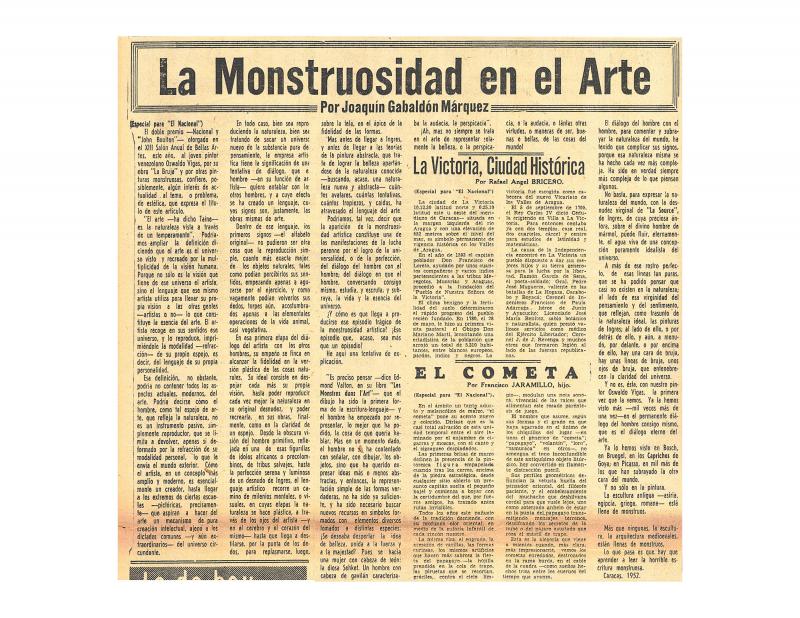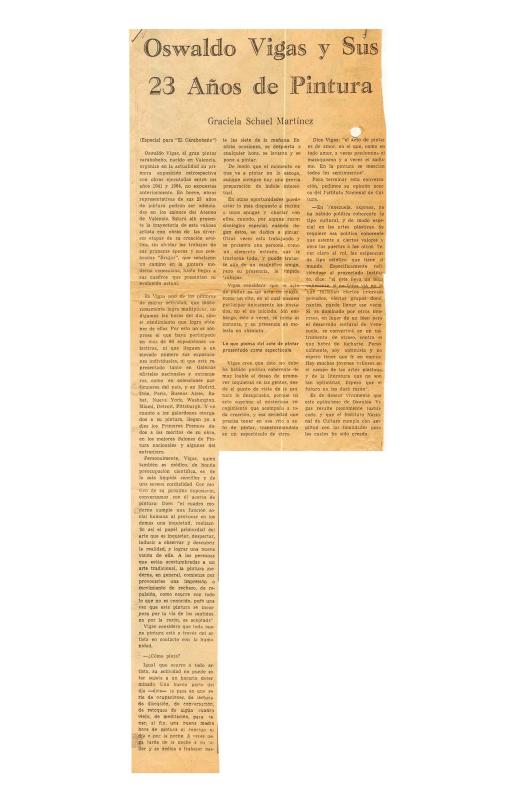When the critic Roberto Montero Castro interviewed the painter Oswaldo Vigas (1926?2014), both men expressed their opinions on two important topics concerning the contemporary art scene in Venezuela: identity and art criticism. The search for identity and the return to past ideas as a way to express the legitimate culture of the continent were two of the main subjects of discussion in cultural circles in the 1970s. Vigas, for his part, played a major role in the Venezuelan visual arts by proposing an aesthetic approach associated with the Latin American self-image, thus addressing the international ideas of the time. This document is important because it takes a penetrating look at how art critics influence the art of a given period and contribute to discussions on matters such as the question of “identity.” Vigas and Montero Castro agree that critics and artists should work closely together for their mutual benefit and in order to consolidate artistic and political theories developed in either discipline. A desirable exchange of this nature, between intellectuals and artists, was once common during the time of the TLA (Taller Libre de Arte) and the Los Disidentes group, both in the early 1950s. As regards the matter of sources and re-interpretations based on Latin American referents, it is interesting to note the discussion concerning the appropriateness of using Western categories to analyze phenomena of an expressive, formal nature. The construction of a Latin American “identity” (in Western terms) would create a profile based on a sense of displacement. The issue remains undecided, as do questions about an idea of identity that—apparently—is in a permanent state of flux.
On the subject of Vigas’ work, see the articles by Marta Traba “Oswaldo Vigas / Pinturas 1943 – 1973” [doc. no. 1106962] and Roberto Guevara “Vigas: proceso abierto” [doc. no. 1152753]. Lenelina Delgado interviews the artist in “De la pintura al tapiz” [doc. no. 1153365]; and Joaquín Gabaldón wrote about La Bruja by Vigas in “La monstruosidad en el arte” [doc. no. 850831]. See also the article by Víctor Guédez “La relación mitificación-desmitificación de la pintura de Oswaldo Vigas” [doc. no. 1153185]; the article by Juan Liscano “La reiteración de Vigas” [doc. no. 1152769]; the article by Roberto Montero Castro “Vigas en el ojo ajeno - Plástica e identidad latinoamericana” [doc. no. 1153266]; the article by A. Feltra “Vigas sufre de afán publicitario” [doc. no. 1155580]; Lucila Velásquez’s interview “Vigas el de hoy: reflexiva evolución de la obra de ayer” [doc. no. 1153202]; Emilio Santana’s interview “Superemos la pugna de abstractos y figurativos: propone Oswaldo Vigas, el pintor que cultiva ambas tendencias” [doc. no. 1153298]; Graciela Schael Martínez’s interview “Oswaldo Vigas y sus 23 años de pintura” [doc. no. 1153282]; and the article by Armando Romero “Oswaldo Vigas: ritos elementales, dioses oscuros” [doc. no. 1153573].












